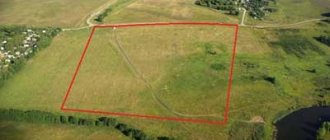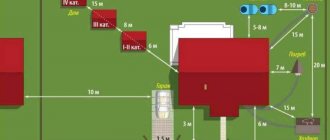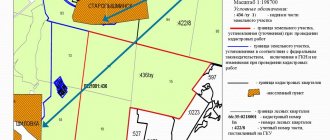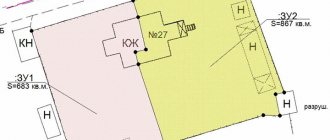On areas allocated for individual housing construction, the construction of private houses, cottages, bathhouses, outbuildings, and so on is permitted. However, despite the fact that the land plots are owned, the statement “my land, I do what I want” does not apply to them.
The standards for building a house on an individual housing construction site in the relevant sectors are quite strictly regulated by SNiP. The documentation indicates the norms for distances from fences, neighboring houses, the red line, the location of objects on the site, and so on. To obtain a building permit, you must provide a plan that will fully comply with SNiP.
Distance between houses and other objects
The distances and location of outbuildings relative to each other are regulated by SNiP 30-02-97 to ensure fire safety. It describes the rules and regulations for location and planning when developing in the private sector and gardening associations. The first thing you need to pay attention to when creating a project is the required distance between houses.
The licensing authorities pay a lot of attention to this point, as it guarantees fire safety. The fact is that when a fire occurs, the fire quickly spreads from one building to another. When constructing a residential property, you need to take into account that the distance is calculated not from the fence, but from the neighboring house.
The distance depends on the degree of fire resistance of the materials used:
- if non-combustible materials (brick, concrete) are used in the construction of a residential building, then the distance is 6 m;
- if during construction flammable materials are used for floors (metal frame with wooden rafters), then a distance of 8 m is required;
- if the cottages are built of wood, then the distance should be 15m.
The exception is the two-row layout. It is also permissible to build two objects back to back if the “1 house for 2 owners” system is used. The distance between buildings is always measured strictly in a straight line, bends and corners are not taken into account.
House construction and land planning
The documents must be correctly drawn up and there must be a certificate of ownership of the land plot. Planning begins with the designation of boundaries - separation by a fence. Fire safety planning is at the core of building codes. Rainwater from the roof should not be directed to an adjacent area of 1 meter. Water supply is carried out independently or centrally. Heating comes from autonomous systems (stoves, boilers). A compost bin should be installed if there is no sewerage system. Gas supply is made from reservoir sources, gas networks or from gas cylinder installations. After completion of all work, documents for real estate should be drawn up.
Distance between houses and other objects
To ensure fire safety, the location of buildings relative to each other is regulated by SNiP. It specifies planning rules and regulations for development. The distance that is required when creating the project itself is what you need to focus your attention on. It is a guarantor of fire safety, since when there is a fire from one building to another, the fire quickly spreads.
Minimum fire safety distances when building a house:
- non-combustible materials (brick, concrete) - 6 meters
- flammable materials (metal with wooden rafters) - 8 meters
- wood - 15 meters
If the layout of the house is designed for 2 owners, then the distance is measured along one line between the buildings.
If suddenly you didn’t already know, we recommend reading the article about the main changes to the Russian Federation Law “On Subsoil” in the latest edition.
Distance to fence
- the distance between the neighbor’s plot and the house is 3 meters
- barn for poultry, livestock, animals - 4m
- shower, baths, toilet - 3m
- garage - 1 meter
- greenhouses - 4 meters
Requirements and procedure for the fence
- The fence should not exceed a height of 1.5 m between land plots.
- To avoid shading, it should not be solid.
- Above 2 m, the fence must be agreed upon with the architectural service.
- Absolutely any fence taller than 1 meter requires approval if it runs along the highway.
Types of land fencing
- panel boards - boards are arranged horizontally or vertically (pine or spruce are the best wood)
- picket fence - planks (vertical) are attached to the beams; the height can be different
- trellises - wooden slats connected into diamond-shaped or square cells
- palisade - fragile in itself
Standards for the location of a house on a plot of land
Before you start building a cottage or house, you need to study the building codes. This is necessary in order to avoid unpleasant consequences. If the standards are not met, then most likely the building will have to be demolished.
Studying the documentation
- standards for placing a house on a plot of land (SP 30−102−99 for individual and low-rise construction; SNiP 30−02−96 for the construction of country houses and soda buildings; SNiP 21−01−97 fire safety)
- draw up a master plan that takes into account standards
- obtaining a topographic image - it shows buildings and neighboring residential buildings
From house to barn
SNiP does not regulate fire distances for the location of buildings on the site. However, it spells out sanitary standards and rules for the placement of economic facilities. They are more advisory in nature, so minor errors are allowed. However, when selling a plot of land in the private sector, problems may arise if these standards are not met.
Distances are calculated from the outer wall of the house in a straight line. All outbuildings in the sector must be located taking into account the following recommendations:
- outdoor toilet at a distance of 12-15m from the house;
- to the bathhouse – 8m, the same applies to showers;
- to barns with livestock and poultry – 12-15m;
- to the compost pit - at least 8 m;
- the minimum distance of economic objects from the house is 4 m;
- It is allowed to install a garage inside a residential building.
The location of buildings relative to each other is also regulated. So, the compost pit and the well should be at a distance of 20m from each other. This is due to the fact that there is a high risk of toxins and other harmful substances getting deep into the soil, from where they can be transferred into drinking water. You cannot place a well next to a fence.
Also, for hygienic reasons, it is recommended to keep the well and toilet at a considerable distance so that wastewater does not get into the water. In this case, the location of the artesian well is not regulated, but it is better to adhere to the above rules, especially if the water is shallow.
Fire safety requirements for the construction of bathhouses are very strict, since they are built mainly from wood. Wood-burning stoves are used inside, which creates an increased risk of fire. The distance from the neighbor's house to the bathhouse must be at least 8 m.
Since 2015, SNiP also applies to the location of the garage. The minimum distance from the fence is 1 m, and from the neighboring property - 6 m. The garage must be located at a distance from the residential building, unless it is located on the ground floor. In this case, additional ventilation will be required.
When and why were the standards for indentation from the boundaries of a land plot invented?
Information on how much to retreat from the fence, from the streets, from neighboring plots and erected buildings during the construction of a house is contained in urban planning and norms and regulations (SNIPs, SanPins), and is also enshrined in the law on fire safety. These norms were developed back in the last century for the safety of citizens, when private property did not yet exist. Over time, taking into account the development and development of territories, the norms and rules have changed along with other land legislation. There are sets of rules that regulate the construction of buildings within the city (SP 30-102-99). There are rules that provide for the development and planning of summer cottages (SP 53.13330.2011). Along with these codes, Sanitary Rules were adopted, which indicate the permissible minimum distances from gas pipelines, farms, wastewater treatment plants to individual buildings (SanPin 2.2.1/2.1.1.1200-03), as well as requirements for fire safety clearances (123-FZ dated July 22, 2008 d.) Let's consider what rules and regulations regarding minimum setbacks from the boundaries of the site apply when building a house on country and garden plots in SNT.
Distance to fence
SNiP pays great attention to the distance between buildings and fences. These are also more hygienic considerations than fire safety requirements, since the location of objects too close to a neighboring plot of land can cause increased shading. This is not always acceptable. So, SNiP specifies the following standards:
- The minimum distance between the house and the neighboring property is 3 m. If the distance is reduced, a document must be drawn up confirming the consent of the parties;
- the barn for animals, poultry, and livestock should be located at a distance of 4 m from the fence;
- sanitary facilities (baths, showers, toilets) at a distance of 2.5 - 3.5 m;
- when installing a greenhouse, the recommended distance is 4 m, this will avoid both shading and the ingress of wastewater with fertilizers onto the neighboring area;
- for a garage and shed with equipment, the minimum distance is 1 m;
- The optimal distance when constructing any buildings is 3m from the fence. This will allow you not to shade the neighbor’s property, as well as avoid conflicts due to the possible penetration of wastewater beyond the fence.
When building a bathhouse, it is better to equip it with an additional drain; for this it is necessary to install a sewer or drain.
What to pay attention to when building a house?
The minimum distance from a residential building (individual housing construction) to the next site is provided for by law and cannot be violated. You need to know this before you order a house project. Otherwise, there is a high risk of a fire quickly spreading from one building to another, from which the entire dacha or cottage community will suffer.
It is best to initially divide the site into residential and commercial areas and provide all the required distances between the buildings and the neighbors’ site.
Compliance with minimum distance requirements affects not only safety, but also comfortable living.
If we are talking about an adjacent territory, then blocking buildings for economic needs is possible, but only with the mutual consent of the neighbors.
Placing trees on the site
Special attention is paid to the placement of trees and shrubs along the fence. Green spaces can create excessive shadow on a neighboring site. However, the neighbor’s claims can only be relevant if the tree is not planted in accordance with SNiP. The distance from the tree to the fence is measured from the center of the trunk. How should green spaces be placed on a plot of land:
- bushes at a distance of 1m from the fence;
- medium-sized trees – 2m;
- tall - 4m.
When planting seedlings, it is necessary to take into account how they will grow in a few years.
What should the fence be like?
SNiP imposes some requirements on the fences themselves. For the most part, they are advisory in nature, and it is not at all difficult to comply with them.
The fence between land plots should not exceed 1.5 m in height . Moreover, it can only be continuous up to the middle. Otherwise, a neighbor may complain about excessive shading of the area.
The choice of fence material remains with the owner of the site; the regulatory documents do not contain any recommendations regarding this. This could be a chain-link mesh, trellises or even a picket fence.
The height of the external fence is not regulated. However, if this figure exceeds 2m, additional approval may be required. The external fence can be solid, for example, made of corrugated sheets.
If you can come to an agreement with your neighbors, you can put up any fence, even a solid fence 3m high. The most important thing is to draw up a document confirming the agreement with the owner of the adjacent plot.
Requirements for individual housing construction
SNiPs regulate not only the location of buildings on sites relative to each other, but also the size of the buildings themselves. The regulatory documents detail the minimum sizes of residential premises:
- the common room (often called the living room) should have an area of 12 sq.m.;
- each bedroom – from 8 sq.m;
- minimum size of kitchens – from 6 sq.m.;
- bathroom – from 1.8 sq.m;
- hallway – also 1.8 sq.m;
- toilet about 1 sq.m;
- ceiling height – from 2.5 m.
Anticipating the desire of owners and developers to save space, SNiPs also prescribe standards for passages. This ensures compliance with sanitary standards and also ensures the safety of residents. The width of stairs and corridors must be at least 0.9 m. The dimensions given are minimum sizes.
For attic floors, a reduction in square footage is provided. For example, bedrooms can be 1 sq.m. less. Regulatory documents also impose restrictions on the use of basements and basements. Residential premises cannot be located below ground level. If the basement is intended to be used for economic purposes, its height must be at least 2 m.
Rules that must be followed when building on a land plot for individual housing construction
Individual housing construction means the construction of low-rise buildings intended not only for buildings, but also for storing food and materials, and raising livestock.
Rules
- convenient location close to the thoroughfare
- conducted and working communications
- developed infrastructure in the area
Fertile soil, development of the area and remoteness from the industrial zone are important conditions for construction.
Subject to compliance with the rules, construction can begin subject to:
- Permission has been obtained for the construction of the building and the relevant documentation is available
- Documents have been checked more than once, including a plan with plot boundaries
Other buildings are possible on the territory of the land plot:
- sheds
- biotoilets
- compost pits
Standards for the area of a house under construction for a plot for individual housing construction
- Living common room - more than 12 square meters. m.
- Bedroom - each more than 8 sq. m. m.
- Kitchen - from 6 sq. m.
- Hallway - from 1.8 sq. m.
- Toilet - more than 1 sq. m.
- Ceiling height - 2.5 m or more
- Stair width - from 0.9 m
Main rules of SNiP for building a house in the private sector
To clarify the location of the house construction, you need to contact the authorities (administration) for help. There you can find out all the standards for construction upon individual request. You cannot build too close or closely; there must be a certain distance between sections. There is no law regarding the location of buildings on private land. There are building rules for garden partnerships. They indicate the distance from the house to other areas and so on. You will risk your own safety if you do not follow the rules. You may also be sued and may be required to pay a fine and change the location of your home. To avoid this incident, it is worth finding out exactly how many meters there should be from the building to other houses.
What are the consequences of failure to comply with SNiP standards when building a house?
It will be necessary to correct sanitary standards, resolve all issues that have arisen with neighbors and certify written consent. The Code of Administrative Offenses defines penalties for non-compliance with the rules for the placement of buildings. The fines are huge.
Communications
A residential building must be equipped with minimal amenities. Communications must be connected to the object. Or you need to provide their analogues.
For the installation of sewerage, it is allowed not only to use pipes and connect to the central collector, but also to install cesspools. In this case, it is necessary to provide filters and cleaning methods for toilets.
Each owner decides the heating issue independently. This could be a furnace or a gas boiler. A system of radiators and convectors can be used. The norm is a heat flow of 10 W per 1 sq.m. The minimum size of the boiler room is 5 sq.m. You can also connect to the central heating system, if possible.
Opening windows are sufficient to ventilate the rooms. Also, the glass must provide an optimal level of lighting. If there is no fresh air supply in the bathroom and toilet, it is necessary to install ventilation.
If a gas connection is provided, the pipeline can only be laid from the side of the boiler or kitchen. It is prohibited to pipe gas through the entire house to the place of use. The exception is when a shut-off valve is installed at the entrance to the room. The gas pipeline cannot be pulled through the foundation. Connections must be welded, threaded inserts are also acceptable.
When using gas cylinders, safety precautions must be observed. The volume of the cylinder should not exceed 12 liters. If they are larger, then they must be kept in a separate room in metal boxes, outside residential premises.
Electricity is most often supplied through overhead power lines. In this case, the wires should not interfere with the roadway. The minimum height at which the cable must be stretched is 2.75 m if there is no active traffic on the street. If a power line passes through busy streets where cars drive and people walk, the wire must be at a height of at least 6 m so as not to interfere with traffic or create a threat.
Power line supports should be located no more than 25m from each other. If the house is located at a greater distance, then it is necessary to install an additional pole. The wires are attached at a distance of 20cm from each other. Energy consumption meters (electricity meters) are installed in special boxes in the house or outside it. Wiring is installed inside the room using insulating materials.
Don't forget about the water supply. You can connect to the central system using plastic or metal water pipes. Artesian wells, water pumping stations, and wells on the site are also often used. Another option is the delivery of drinking water. The issue with hot water is solved by installing a boiler.
Standards determining the distance from the house to neighboring buildings
If you plan to build a low-rise private house (1-2 floors), then according to regulatory requirements it must be built at a distance from the street of at least 5 m, and from the red line of passages - at least 3 m.
From sheds, garages and other buildings should also be at least five meters from the street.
Setback from the site boundary during construction:
- to the house (individual housing construction) - at least 3 meters from the neighboring plot;
- to the poultry house, barn - at least 4 meters;
- to the location of the bathhouse, garage and other buildings - at least 1 meter.
The distance from the windows of one house to the walls of a neighboring house and its garages and other buildings must be at least 6 m . Even the distance to trees (at least 4 m) and bushes (at least a meter) is regulated.
When building a country house at home, you need to take into account that sanitary conditions require that the neighbors be at least three meters away. From the barn or poultry house to the neighboring plot there must be at least four meters. From other buildings - at least a meter.
As you can see, the requirements for the minimum distance for country houses, garden houses and low-rise buildings built outside the city are almost identical. Exceptions are wooden houses, which are more susceptible to fires. For them, the so-called fire gap must be at least 15 meters.
Permissible distance from a garage, bathhouse, outbuilding, toilet, septic tank, cesspool to other building objects
When developing a site, not only a house is built, but also many other buildings. The distance from them to the neighbors’ living quarters must be at least 6 meters.
If the sewerage system has not yet been connected and a temporary toilet has been installed, then the distance to the walls of the neighbors’ house should be at least 12 m, and to the pump or well - at least 25 meters.
A toilet can only be connected to a central sewerage system or in the form of a cesspool, composted waste disposal (creation of powder closets, dry closets). Cesspools must be well insulated. For wastewater, filter trenches with a layer of gravel and sand are made on the site.
The distance between the column and the composter must be at least 8 meters. A minimum of 12 meters is required between the house, cellar and toilet, and showers, baths, saunas should not be placed closer than 8 meters. If the size of the plot itself does not imply such large distances, then no exceptions are made anyway. However, as practice shows, up to 95% of summer residents and owners of country real estate violate construction standards.
How are acceptable segments measured?
You need to measure the distance to your neighbors correctly: from the base or wall of the house to the neighbor’s fence. For protruding elements, for example, a porch or canopy, you need to measure from the protruding parts (if the protrusion is more than 50 cm).
The minimum distances to the border of the neighboring plot, as well as the distance from the road to the border of the land plot, are measured with a special measuring tape or rangefinder.
Fire safety requirements
In SNiPs, fire safety requirements are not included in a separate chapter. They are comprehensive and are present in every section. One of the fire safety rules is to place buildings at a certain distance from each other. The material of construction will also play an important role.
Another fire safety rule is the use of fire-resistant materials when finishing and strengthening the building. Fire safety is also ensured by proper communications: it is necessary to regularly check the condition of wiring, gas pipes and connections, electrical appliances, and so on.
If fire safety requirements are violated, there is a possibility that the house will not be allowed to be put into operation or will even be required to be demolished.
Development standards relative to the red line
This is another not very clear section in SNiPs. Not everyone knows and understands what is hidden behind the concept of a red line.
The red line is a conditional boundary, a line running between the site and the roadway, separating them from each other. Often this is where the fence is installed. So, the red line separates the development area from the adjacent territory.
During construction, it is necessary to take into account the location of the red line. Buildings are placed taking this trait into account. Thus, one of the requirements of SNiP is to place a residential building at a distance of 5 m from the red line. Buildings should not protrude beyond it, and some should be located at a considerable distance.
If this requirement is violated, the court may order the demolition of the building protruding beyond the red line. Neglect may also result in a fine. So, when planning and construction, it is necessary to remember that objects should not protrude beyond the red line.
What regulatory documents, SNiP, GOST regulate the issue?
The issue of the minimum distance between sites is regulated by a variety of regulations. For example, the Urban Planning Code, which regulates the preparation of a development plan, the Land Use and Development Rules, SNiP and GOST, which sets requirements for the quality of concrete and other structures.
The minimum setbacks are indicated on the drawing of the urban planning plan of the land plot and they must be observed during construction.
What you need to know before construction begins:
- Town Planning Code of the Russian Federation;
- for a low-rise building: SP 30-102-99 (clauses 5.3.2, 5.3.4, 5.3.8);
- for country houses, outbuildings and other buildings: SNiP 30-02-97, SP 42.13330.2011, SP 53.13330.2011:
- Charter of SNT (if we are talking about a dacha).
The minimum distance footage is determined in accordance with lighting standards and fire safety requirements. The city has its own red building line, which must be adhered to.
Violating the established standards is only possible if the site has uneven terrain , for example, lowlands and hills, and compliance with the requirement is in principle impossible. If a bathhouse is being built in a residential building, then the requirements may also be violated, but first you need to obtain official permission to build such a facility.
GOST establishes requirements for the quality of materials from which buildings are made (from wood to concrete, cement), pipes, floors and other important construction details. These norms also cannot be violated, otherwise this could lead to the collapse of buildings and possible death of people.









